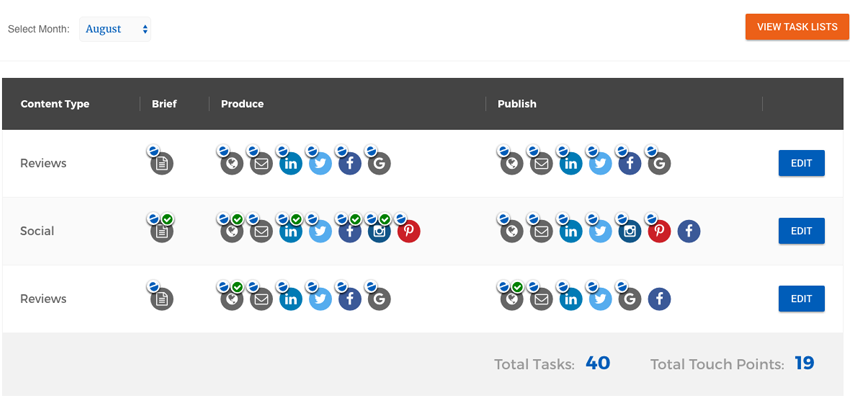Step 3 – Understanding your consumers
Next is establishing your target market. Segmenting your market can help to uncover valuable insights about your target audience so you can tailor your content to their needs and ensure you communicate the correct tone of voice. You can do this by creating a consumer profile, identifying variables such as:
Who is your average customer?
Geographical
Are you targeting a specific location ?
Demographic
Are you targeting a specific age or gender ?
Psychographic
Do your customers have specific interests or attitudes towards your products/services ?
Behavioural
Are your customers ready to purchase ? Where are they are the buying cycle ?
Where are they in their buying journey?
Today’s consumers use multiple devices and channels to purchase products/services so understanding their behaviour gives you a credible perception of their journey to purchase.
Awareness:
Do your customers know your service exists ? It’s important to understand what activity you are currently carrying out to increase your brand awareness. Engaging on social media platforms or display advertising such as remarketing can be highly effective.
Research:
When customers are conducting research it is important we rank for the keywords they are searching for in search results. Keyword research is key to identifying what users are searching for. This provides you with a basis of what content you need to create. Very often businesses end up using their own interpretation of what a user would search for and therefore limit their engagement with potential customers
Consideration:
The consideration stage is similar to Google’s I-want-to-know moment where consumers engage in further search to evaluate their options. This is where content such as reviews or multimedia can be used to help influence them through to purchase
Purchase:
Are you ahead of your customers and competitors ? Similar to Google’s I-want-to-buy moment this stage offers businesses opportunities to connect with consumers in a way that influences them to complete a purchase. So you need to question what are you doing to interact with consumers ?
Step 4 – How do you engage with your consumers?
You need to review what stage your current marketing content targets and identify opportunities to refine this process. In our experience websites only create content that target those at the purchasing stage. This approach overlooks all those consumers at the awareness, discovery and consideration stages, thus potentially missing out on a conversion. Developing a few road maps of what your potential customer journey may look like will help clarify what type of content you need to produce.
Step 5 – What platforms are you using?

Step 6 – What content can you produce that helps your consumers?
So by this stage you will have grasped that content is the key to moving potential customers along to the next stage of the purchasing journey. We can now identify what content types you need to focus on:
How to guide
Guides are ideal for moving consumers from researching a product/service to consideration and in some cases all the way through to purchasing, especially with high involvement products/services such as buying a car. They are informative and aimed towards eliminating any queries
Keyword content
Keyword content can be aimed towards research, consideration or purchase depending on the keyword you are targeting. Some keywords tend to be more generic indicating the consumer is browsing, but keywords that are more long tailed or more specific means the user is looking to consider or invest in most cases, therefore you need to identify what they are searching so you can produce content tailored to their needs
Company Update
Reviews
Purchasing is a repetitive action therefore companies should create positive post-purchase communication to increase loyalty and positive feedback. Reviews are a way of restoring confidence in the consumer, especially if they are in the consideration or purchase stage. Reviews deem you as credible and trustworthy enough to deliver the customers needs, especially as they are honest and come from a reliable source.
Case Study
Case studies tend to be highly compelling for customers who are considering purchasing your product/services. They provide rich detail and give an idea of what they can realistically expect
Lists
Lists tend to be effective content for those in the research stage. They can come in many forms:
Checklists i.e. Follow this checklist to achieve an outcome
Negative i.e. Things you should NOT do to achieve an outcome
Positive i.e. Things you should do to achieve an outcome
Tips i.e. Top 10 tips to help you achieve your outcome
Social
As mentioned above, consumers may be unaware they are in need of your products/services, therefore posting content on social platforms can raise awareness, encourage sharing to other potential customers, thus pushing them through to research
News Update
News updates can useful at targeting both awareness and consideration. If there is a new product/service then sharing this on social media platforms can be proactive, but on the other hand if you regularly share news updates and see authoritative on a subject consumer will deem you as a credible business in the industry and maybe purchase
Multimedia
Content can come in the form of writing, images or video. Video marketing has been on the increase and can be highly powerful for targeting consumers who are researching or consideration buying your product/service. For example,. Google identified consumers used YouTube to make final purchasing decisions
Interview
An interview with an industry expert can be predominantly more persuasive for those researching or considering their purchasing options. Experts are sources of knowledgeable assertions and tend to be trusted to give an opinion on the subject
Opinion
Content that gives your opinion positions you as a leader in your industry and not only helps customers researching but is especially useful for to help customers consider you above your competitors.
Legislation Update
This is content that can help to define you as a leader in your field which can help position you ahead of your competitors. Helpful for potential customers who are in the consideration stage.
Step 7 – Monthly Marketing Activity

Step 8 – Touch Points and Integration
The image below depicts a series of touchpoints and how content can be spread across a number of platforms to gain impressions, user engagement and shares. Each touchpoint creates an opportunity to move the potential customer further along the ‘customer journey’ and closer to the purchasing decision. For example:
- When you optimise a piece of content on your website users are able to view it
- When you post a piece of content on social media users are able to share it
- When your customers receive an email you are able to see who interacts and generate leads
Summary
Following these steps maximises your opportunity to reach consumers throughout the customer journey and increase your presence across all digital channels.
If you would like help to produce a plan follow the link below and our system will email you a link with a monthly calendar plan or contact 01216678785 for more further information.













